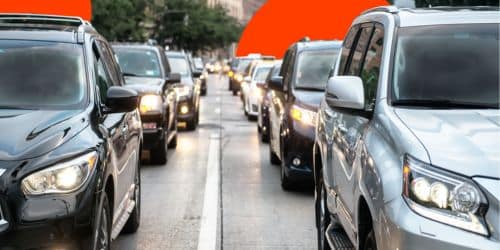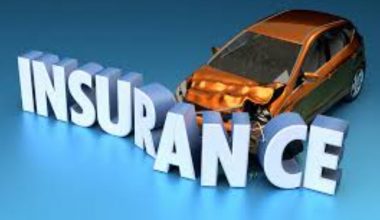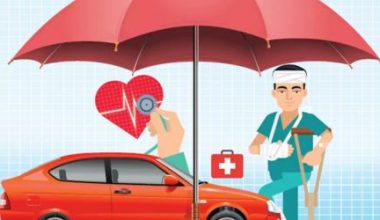If your car insurance company classifies you as a high-risk driver, you will almost certainly pay more than the average driver.
You could be classified as a high-risk driver for a number of reasons. It could be due to your driving records, such as a history of tickets, accidents, or DUI/DWI convictions. It could also be due to particular traits, such as being a young or inexperienced driver or having poor credit.
While you may pay higher rates for coverage if you have one or more of these characteristics on your record, that doesn’t mean you can’t get the best possible price for coverage depending on your circumstances. Shopping around for coverage, improving your credit, and bundling your insurance policies could all help you save money on your premium or the price you pay for coverage.
What is High-Risk Car Insurance?
High risk car insurance is often not much different than standard car insurance. The biggest distinction is the driver and the cost of car insurance. In the view of car insurance companies, high risk drivers appear to be more prone to file claims and, as a result, have higher car insurance premiums.
It can be difficult to get low-cost high-risk car insurance. It is necessary to browse around with the top car insurance companies in order to discover the cheapest price.
Aside from the cost, another distinction in high-risk car insurance is that it sometimes necessitates the filing of an SR-22 with the state to confirm the driver has car insurance. The reason you need SR-22 insurance, not the SR-22 itself, places you in a high-risk category with car insurance companies.
A state may demand an SR-22 for a variety of reasons, including a DUI conviction or getting involved in a vehicle accident without car insurance. If you require an SR-22, you should only compare car insurance companies that provide SR-22 filings. SR-22s are required by all of our top recommendations for high-risk car insurance.
Factors Contributing to a High-Risk Driver
Car insurance companies look at a variety of factors to evaluate how much risk you pose.
When you are considered to be more likely to file a claim than the majority of drivers, you are classified as a high-risk driver.
Certain driving and non-driving behaviors and difficulties, such as significant offenses like a DUI, a history of auto accidents and claims, or even bad credit, cause auto insurance companies to view you as a high-risk driver. Here are some of the most prevalent variables that may cause car insurance companies to classify you as a high-risk driver.
#1. At-Fault Insurance Claims
If you’ve filed at-fault car insurance claims, insurers will view you as someone who may make dangerous decisions on the road, leading in accidents and claims. According to car insurance companies, this makes you a high-risk driver.
According to Forbes Advisor’s research, car insurance rates rise by 40% on average following an injury accident. In our survey of car insurance premiums after an accident involving injuries, that is more than $800 more per year than a good driver with a clean driving record pays.
After a property damage collision, car insurance costs rise by 38% on average. According to our estimate, you’ll pay about $776 more per year for auto insurance than an excellent driver.
A minor accident may not have a significant impact on your car insurance prices, especially if you have accident forgiveness coverage through your auto insurance company. Furthermore, unless you have made many car insurance claims, certain car insurance companies may not consider you a high-risk driver.
#2. DUI
According to a Forbes Advisor analysis, drivers with a DUI face an increase in insurance prices of 72% on average. The difference in annual costs between a competent driver with a clean driving record and a high-risk driver with a DUI is over $1,400.
Car insurance prices after a DUI are so high because drunk drivers pose a large risk of getting involved in a major accident. Being under the influence of alcohol can impair your judgment, coordination, and reaction times, all of which can have a significant impact on your abilities behind the wheel, increasing your chances of being involved in a vehicle accident.
According to research conducted by the National Highway Traffic Safety Administration (NHTSA), drivers with a breath alcohol concentration (BrAC) of 0.08 had four times increased risk of collision than drivers with a BrAC of 0.00. Furthermore, the CDC reports that nearly one-third of all road fatalities in the United States include a driver with a blood alcohol content of 0.08 or higher—the legal limit in most states.
#3. Speeding Tickets
After a speeding violation, car insurance premiums rise by 21% on average. This equates to paying more than $400 more in auto insurance per year than a driver with a clean driving record.
Car insurance companies consider speeding to be risky behavior because if you get into an accident while speeding, you’re more likely to inflict more damage, resulting in higher claim payouts. According to an NHTSA analysis, speed was a factor in 29% of fatal traffic crashes in 2020.
After a speeding ticket, you’ll pay more for car insurance, but how much depends on whether it’s your first driving infraction and how far over the speed limit you were going. Multiple speeding fines indicate a trend of riskier driving and classify you as a high-risk driver.
#4. Unsafe driving
According to our data, the average rise in auto insurance prices after a reckless driving ticket is 61%. Car insurance rates climb by more than $1,000 per year on average following a reckless driving ticket, demonstrating how seriously car insurance companies take this crime.
It might be difficult to define reckless driving because the definition varies from state to state. Driving with an intentional or wanton disregard for the safety of individuals or property is a typical definition. In summary, it’s reckless driving that could lead to a serious accident, which is why you’re called high risk if you have this conviction on your driving record.
#5. Credit
According to Forbes Advisor’s data, car insurance premiums rise by 79% on average for drivers with bad credit. According to our analysis, drivers with bad credit pay around $1,500 more per year than those with strong credit.
Car insurance premiums are high for drivers with bad credit because vehicle insurance companies believe that credit predicts the likelihood of a claim. Drivers with poor credit are perceived to be more likely to file claims, hence they are deemed a higher risk to insure in most jurisdictions.
California, Hawaii, Massachusetts, and Michigan have all prohibited the use of credit when determining car insurance rates.
#6. Age
Some drivers are considered high-risk by car insurance companies because their age group is more likely to be involved in accidents and file claims than others. Teenagers and seniors, on average, pay more for car insurance than other age groups.
According to our analysis of annual teen car insurance premiums, the average increase in auto insurance costs for parents adding a 16-year-old driver to their policy is 92%. According to our data, an 18-year-old on their own policy pays 150% more in car insurance per year than a 25-year-old driver.
Teen drivers are young, inexperienced, and more prone to crash, thus their car insurance prices are greater. According to the Insurance Institute for Highway Safety (IIHS), the fatal collision rate per mile traveled for 16 to 19-year-old drivers is roughly three times that of drivers aged 20 and up.
The IIHS reports a significant increase in fatal collisions among drivers aged 70 to 74, with the highest rate among drivers aged 85 and older. Senior drivers aged 70 and older have greater experience, but their reaction times are slower and they are more prone to injuries, thus they are rated as higher hazards.
According to our survey of annual auto insurance expenses, car insurance premiums are 34% more on average for a senior driver aged 80 compared to costs at age 60.
Age is not a factor in calculating auto insurance prices in California, Hawaii, or Massachusetts according to state restrictions.
#7. Location
If the area where you reside has a high number of claims, your location may put you in a high-risk category with car insurance companies.
For example, if you live in a congested metropolitan location prone to more car accidents, or in an area prone to car theft, vandalism, or even extreme weather, these factors can result in a higher-than-average incidence of claims and make you riskier to insure.
For example, Florida is prone to severe weather, such as hurricanes, and its average car insurance price is more than 300% higher than in Idaho, which has gentler weather.
Cheapest Car Insurance for High-Risk Drivers
According to Forbes Advisor’s review of annual rates from top vehicle insurance companies, high-risk car insurance costs an average of $3,217 per year.
According to our research, USAA has the cheapest high-risk car insurance at $2.379. However, USAA has strict eligibility requirements. To acquire car insurance via USAA, you must be a member of the military, a veteran, or a family member of either.
If you do not qualify for high-risk car insurance through USAA, Geico is the next cheapest at $2,704, followed by American Family at $2,995. When looking for low-cost car insurance, here are some of the best companies to consider.
The high-risk driver prices are based on average car insurance costs for four groups of drivers: those with a DUI, those with an at-fault accident with property damage, those with an at-fault accident with injury, and those with low credit.
Cheapest High-Risk Car Insurance Company By Insurance
| Company | Average annual cost | Average monthly cost |
| USAA* | $2,379 | $198 |
| Geico | $2,704 | $225 |
| American Family | $2,995 | $250 |
| Nationwide | $3,049 | $254 |
| National Average | $3,217 | $268 |
Cheapest High-risk Car Insurance By State
| State | Cheapest company for high-risk drivers | Average annual cost | Average monthly cost |
| Alabama | Travelers | $1,798 | $150 |
| Alaska | Umialik | $2,034 | $169 |
| Arizona | Root Insurance | $1,070 | $89 |
| Arkansas | Cameron Mutual | $1,972 | $164 |
| California | Wawanesa | $2,261 | $188 |
| Colorado | Colorado Farm Bureau | $2,055 | $171 |
| Connecticut | Travelers | $2,095 | $175 |
| Delaware | Travelers | $2,094 | $174 |
| Florida | Geico | $4,018 | $335 |
| Georgia | Country | $2,414 | $201 |
| Hawaii | State Farm | $1,540 | $128 |
| Idaho | American National | $826 | $69 |
| Illinois | Mercury | $2,480 | $207 |
| Indiana | Pekin Insurance | $1,263 | $105 |
| Iowa | Hastings Mutual | $1,203 | $100 |
| Kansas | Geico | $1,729 | $144 |
| Kentucky | Travelers | $2,242 | $187 |
| Louisiana | Southern Farm Bureau | $3,903 | $325 |
| Maine | Concord Group | $1,189 | $99 |
| Maryland | Travelers | $3,214 | $268 |
| Massachusetts | State Farm | $1,936 | $161 |
| Michigan | Secura | $1,767 | $147 |
| Minnesota | American Family | $2,576 | $215 |
| Mississippi | Safeway | $1,816 | $151 |
| Missouri | Umialik | $2,034 | $169 |
| Montana | Progressive | $1,868 | $156 |
| Nebraska | Geico | $1,532 | $128 |
| Nevada | American Access | $2,630 | $219 |
| Hampshire | MMG | $1,429 | $119 |
| New Jersey | NJM | $1,605 | $134 |
| New Mexico | Nationwide | $2,075 | $173 |
| New York | NYCM | $4,249 | $354 |
| North Carolina | North Carolina Farm Bureau | $1,898 | $158 |
| North Dakota | Nodak Mutual | $1,255 | $105 |
| Ohio | Hastings Mutual | $1,045 | $87 |
| Oklahoma | Oklahoma Farmers Union | $2,456 | $205 |
| Oregon | Oregon Mutual | $1,503 | $125 |
| Pennsylvania | American National | $3,427 | $286 |
| Rhode Island | State Farm | $1,673 | $139 |
| South Carolina | Travelers | $2,160 | $180 |
| South Dakota | Farmers | $2,061 | $172 |
| Tennessee | Tennessee Farmers | $1,659 | $138 |
| Texas | Geico | $2,671 | $223 |
| Utah | Geico | $2,088 | $174 |
| Vermont | Geico | $1,085 | $90 |
| Virginia | Virginia Farm Bureau | $1,350 | $113 |
| Washington | Pemco | $1,491 | $124 |
| West Virginia | Nationwide | $1,838 | $153 |
| Wisconsin | Secura | $1,500 | $125 |
| Wyoming | American National | $899 | $75 |
Read Also: SR-22 INSURANCE: How It Works
Our research on the cheapest car insurance company in each state reveals Geico and Travelers are the cheapest in six states each, but the broad range of cheapest companies in different states underlines the need of comparing car insurance quotes.
When looking for the best insurance for high-risk drivers, it’s a good idea to browse around with both large and small auto insurance companies to discover the insurer that will offer you the best pricing and coverage for your needs.
How to Save Money on High-Risk Car Insurance
It may be more difficult to obtain cheap car insurance if you are classified as a high-risk driver. Here are some ideas for lowering your car insurance expenses.
#1. Compare the quotes.
The simplest method to save money is to look around for the best car insurance for high-risk drivers.
Car insurance company prices vary widely, thus as a high-risk driver, you must compare car insurance quotes from at least three different companies. Car insurance quotes are free and can be obtained online, via phone, or in person, depending on which method works best for you.
When shopping for car insurance, request the same coverages and limits to locate the best-fitting auto insurance company for your needs. If you require an SR-22 filing or non-owners car insurance coverage, ensure that the auto insurance companies you examine offer these options.
#2. Enroll in a defensive driving course.
Some car insurance companies will give you a discount if you attend a defensive driving course to enhance your driving skills. This can help you save money on car insurance while also identifying and correcting driving behaviors that have put you in the high-risk group.
If you’re taking the defensive driving course particularly to get a discount, ask your car insurance company for a list of approved companies and be sure to send proof of completion to the insurer.
#3. Know when you should file a collision claim
Collision insurance can cover car damage repairs caused by an unintentional collision with another vehicle or object, regardless of culpability. If you file an auto insurance claim for every minor problem, it can rapidly build up and place you in a high-risk group for filing multiple claims.
Before filing an auto insurance claim, make sure the damage is greater than your deductible and worth filing a claim for. For collision and comprehensive insurance claims, your deductible is the amount deducted from the claim check.
Assume you have a $1,000 deductible and $1,250 in car damage. In this case, your car insurance company would only pay $250 on a claim. Is that small sum worth the rise in car insurance premiums you may face over the next three to five years as a result of filing a claim? Most likely not.
Avoid getting collision coverage if you have enough money to compensate for small accidental damage to your vehicle. Wait to file a collision insurance claim for serious damage that may necessitate pricey repairs.
#4. Increase your deductible.
The amount removed from car insurance collision and comprehensive claim checks is known as the deductible. Raising your car insurance deductible will save you money because your auto insurance company will pay less for claims.
For example, switching from a $500 deductible to a $1,000 deductible saves you 11% on average. A greater deductible may also help you reduce the number of claims you file with your car insurance company, lowering your car insurance expenses.
#5. Look for discounts
When receiving car insurance rates, inquire about discounts that can help you save money.
Depending on why you’re considered a high-risk driver, you may not be eligible for a claims-free or accident-free discount, but there are plenty of alternative car insurance discounts. Look into discounts for:
- Paying your car insurance in full rather than monthly
- Getting rid of paper
- Using electronic funds to pay
- Using your car insurance policy to insure several vehicles
- Combining your car and house insurance coverage with the same company
- Your car is equipped with anti-theft technology.
- Your vehicle is equipped with safety measures such as anti-lock brakes and airbags.
- Being an excellent student or having a good student as a child on your policy
If you want to demonstrate to your car insurance company that you drive safely, you can enroll in a usage-based car insurance program. Your driving is tracked with a usage-based insurance (UBI) plan. You usually get a discount just for joining in the program, and you can obtain a higher discount if you demonstrate good driving practices. Be advised that some UBI plans will raise your rates if you have a low score for driving habits such as speeding or forceful braking.
How Can You Reduce Your Risk?
Lowering the risk you pose will help you save money on car insurance. Here are some actions you may take to find reduced car insurance rates.
#1. Be a cautious driver.
Strive for a spotless driving record. That is one that does not have any traffic violations or accidents on it. While it may take three to five years for a previous traffic infraction or accident to be removed from your driving record, maintaining a clean record can assist car insurance companies believe you’re now a safer driver.
#2. Increase your credit score.
In places where credit can be used as a rating component, improving your credit score will help you acquire reduced car insurance rates.
#3. Driving less
You have a lower risk of being in an accident if you drive less. If your circumstances have changed, such as working from home or retiring, notify your car insurance company that your annual mileage has fallen to see if your car insurance prices will also decrease.
#4. There should be no gaps in coverage.
If you have not kept your car insurance current or if this is your first car insurance coverage, you may be considered a high-risk driver. Get and keep car insurance to reduce your risk. Having active vehicle insurance coverage on a consistent basis can also lead to discounts, such as loyalty discounts if you stay covered with the same company for a number of years.
What is the Cheapest Car Insurance for High-risk Drivers?
You should look around for coverage depending on your scenario. Each car insurance company evaluates your risks differently and adjusts your premium appropriately. Obtaining estimates from multiple different car insurance companies will assist you in ensuring that you are paying the correct price for the coverage you require.
How Long Can You Be Classified as a High-Risk Driver?
In general, variables such as at-fault accidents and speeding fines have a three to five-year impact on your insurance. DUIs or reckless driving may result in a permanent mark on your record. However, the amount of time these things remain on your record is determined by the state in which you live.
What if I’m Turned Down for Coverage Because I’m a High-Risk Driver?
If you are denied vehicle insurance coverage by one company, it is worthwhile to check with another. When selecting whether or not to insure a driver and how much to charge, each company takes a different approach. An insurance agent can also assist you in locating coverage that is appropriate for your needs and driving record.
There are solutions if you’re still having difficulties receiving coverage. Investigating a state-assigned risk pool could be one option to obtain insurance as a high-risk motorist. These pools can assist ensure that you have coverage, however, the cost may be greater than you could receive on your own.
Conclusion
You can still receive coverage if you have a speeding ticket, an at-fault collision, or a DUI on your driving record. Do your study and compare various estimates to make your coverage more inexpensive, look for bundling opportunities, and improve on your credit score.
Related Articles
- Best Car Insurance For High-risk Drivers: 2023 Comparison
- COLLISION INSURANCE: Meaning & Coverages
- NEW DRIVER CAR INSURANCE: What It Is, Costs & How It Works
- Cheapest No Down Payment Car Insurance In 2023





